Comments / Questions (64)
![]() Karla Silva wrote:
Karla Silva wrote:
Mi hija acaba de cumplir 4 años esta bien realizar la prenda en talla de 3 a 4 años.....? por que la talla de 5 a 6 creo que sera muy grande para ella.
28.03.2020 - 19:36DROPS Design answered:
Hola Karla. Para elegir la talla correcta como referencia puedes usar las medidas de la prenda bajo el patrón. Cuando tengas dudas entre dos tallas recomendamos elegir la talla más grande.
29.03.2020 - 23:11
![]() Christina Christensen wrote:
Christina Christensen wrote:
Når jeg har taget 11 gange ud i størrelse 5/6 år, så får jeg 282 masker og ikke 280. De 282 passer også med regnestykket 144+50 (5x12)+88(11x8). Hvor regner jeg forkert? Mvh Christina
19.03.2020 - 22:53DROPS Design answered:
Hej Den första ökningen gör du totalt 4 gånger; 4 x 12 =48 m. 144+48+88= 280 m. Lycka till!
20.03.2020 - 06:57
![]() Nicky Middleton wrote:
Nicky Middleton wrote:
I have reached the point in this pattern where I have separated for sleeves and body. All good so far, but please can you explain why the first and fourth markers indicate (=side) instead of mid -front and mid-back? Are these the correct places for increasing? Thank you in advance!
09.03.2020 - 23:20DROPS Design answered:
Dear Nicky, you have to put the markers , and decrease and increase at the sides for waist shaping and shaping the skirt of the dress, which you don't do at the middle of the front and back BUt at the sides. I hope this helps. Happy Knitting!
10.03.2020 - 05:22
![]() Marie wrote:
Marie wrote:
Tack för svar! Jag var nog otydlig. Det är på varv 2 och 3 i diagrammet som det blir tokigt. Gör jag ingen förskjutning på första aviga så stämmer det, men blir fel på tredje...
05.03.2020 - 17:08DROPS Design answered:
Hej Marie Är inte helt säker på att jag förstår vad du menar, men den första aviga i diagrammet gör du alltid på den första maskan på varvet, då ska mönstret stämma. Hålmönstret ska komma i linje uppåt. Mvh DROPS Design
06.03.2020 - 13:30
![]() Marie wrote:
Marie wrote:
Efter halsresåren, börjar man diagrammet med en avig maska och följande maskor varvet ut? Den aviga maskan ställer till det för mig. På nästa varv hamnar det fel och mönstret stämmer inte. Läser från höger till vänster nerifrån och upp. Hittar ingen video på just det diagrammet.
04.03.2020 - 20:51DROPS Design answered:
Hej Ja det stämmer, du börjar diagrammet med den aviga maskan, sedan stickar du 2 räta maskor, 1 omslag, 1 rät maska, 1 omslag, 2 räta maskor (för storlek 3/4 + 5/6). Detta upprepar du det antal gånger du ska för din storlek. Lycka till!
05.03.2020 - 14:35
![]() Linnea wrote:
Linnea wrote:
Hej! Findes der mon en opskrift til voksne med dette fine mønster?
01.02.2020 - 19:36
![]() Ciara wrote:
Ciara wrote:
Hello, I'm knitting this model for a 3/4 years old size, but I don't understand how to make the pattern: I have 66 stitches, how can I repeat it for 11 times?
03.12.2019 - 10:33DROPS Design answered:
Dear Ciara, you will repeat the diagram A.1 a total of 11 times over the 66 stitches - see diagram A.1 for the size = 3/4 (same for 5/6): on first row A.1 is worked over 6 sts (+ 2 sts inc on 1st row). Read more about diagrams here. Happy knitting!
03.12.2019 - 12:59
![]() Winki wrote:
Winki wrote:
Der untere Rand klappt nach oben. Was kann ich tun?
29.11.2019 - 09:47DROPS Design answered:
Liebe Winki, Sie können das Kleid mit Stecknadeln auf einer geeigneten Unterlage spannen, anfeuchten (z.B. mit einer Sprühflasche für Blumen) und trocknen lassen, danach entfernen Sie die Stecknadeln, dann sollte sich der Rand nicht mehr rollen. Viel Spaß beim stricken!
29.11.2019 - 10:31
![]() Winki wrote:
Winki wrote:
Bei den anbringen der Markierungsfäden heißt es: den 1. Markierer in der 1. Masche der Runde anbringen (= Seite),jedoch idz doch det Rundenanfang : Mitte hinten
05.11.2019 - 18:04DROPS Design answered:
Liebe Winki, bei der Passe beginnen die Runden in der hintere Mitte, aber wenn man dann den Rumpfteil strickt, werden die Runden unter einen Ärmel anfangen (= Mitte in den neu 6 angeschlagenen Maschen). Viel Spaß beim stricken!
06.11.2019 - 08:29
![]() Christine wrote:
Christine wrote:
What is the yardage/metre requirement for each size? I must be missing it somewhere?
04.11.2019 - 20:54DROPS Design answered:
Hi Christine, We state the yarn amounts in grams, but the length is shown if you read about the specific yarn under 'all yarns'. Drops Merino Extra Fine gives approx. 105 metres per 50 grammes. Happy knitting!
05.11.2019 - 07:17
Woodland Fairy#woodlandfairydress |
||||||||||||||||||||||
 |
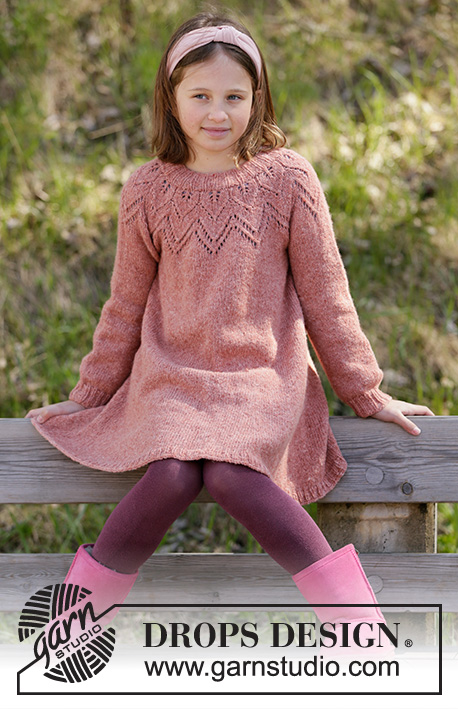 |
|||||||||||||||||||||
Knitted dress for children in DROPS Sky or DROPS Merino Extra Fine. The piece is worked top down with lace pattern. Sizes 3-12 years.
DROPS Children 34-25 |
||||||||||||||||||||||
|
------------------------------------------------------- EXPLANATIONS FOR THE PATTERN: ------------------------------------------------------- INCREASE TIP: Increase with 1 yarn over; on the next round work the yarn over twisted to avoid a hole. PATTERN: See diagram A.1; choose your size in the diagram. ------------------------------------------------------- START THE PIECE HERE: ------------------------------------------------------- DRESS: The yoke is worked in the round, top down. After the piece has been divided for body and sleeves, the body is continued in the round with circular needle, and the sleeves are workedin the round with double pointed needles. YOKE: Cast on 72-78-84-90-96 stitches with short circular needle size 3.5 mm and Sky. Insert 1 marker at the beginning of the round (= mid back). Work rib with knit 1/ purl 2 for 3-3-4-4-4 cm (= neck). The piece is now measured from here. Change to short circular needle size 4 mm and knit 2 rounds, adjusting on the first round the number of stitches to 66-72-78-84-91 stitches. Then work A.1 (= 11-12-13-12-13 repeats in width) – see diagram for the correct size! REMEMBER THE KNITTING TENSION! Change to a longer circular needle when you have increased enough stitches. When A.1 has been completed there are 198-216-234-240-260 stitches on the needle. On the next round increase 14-12-10-24-20 stitches evenly spaced while at the same time working stocking stitch = 212-228-244-264-280 stitches. Continue with stocking stitch until the piece measures 12-13-14-15-16 cm (without the rib). The next round is worked as follows: Knit 31-33-35-37-39 stitches (= half the back piece), place the next 44-48-52-58-62 stitches on 1 thread for sleeve (without working them), cast on 6 new stitches, knit 62-66-70-74-78 stitches (= front piece), place the next 44-48-52-58-62 stitches on 1 thread for sleeve (without working them), cast on 6 new stitches and knit 31-33-35-37-39 stitches (= half the back piece). BODY: = 136-144-152-160-168 stitches. THE PIECE IS NOW MEASURED FROM HERE! Now insert 6 markers in the piece as follows: Marker 1 is inserted in the first stitch at the beginning of the round (= side), marker 2 is inserted in the 23rd-25th-26th-27th-28th stitch, marker 3 is inserted in the 47th-49th-52nd-55th-58th stitch, marker 4 is inserted in the 69th-73rd-77th-81st-86th stitch (= side), marker 5 is inserted in the 91st-97th-102nd-107th-114th stitch, marker 6 is inserted in the 115th-121st-128th-135th-144th stitch (there are 21-23-24-25-24 stitches left on the round after the last marker). READ INCREASE TIP! On the next round increase 1 stitch on each side of each marker (12 stitches increased on round) and repeat these increases every 1½-2-2-2-1½ cm a total of 4 times. Then increase as follows: Increase 1 stitch on each side of markers 1 and 4 (= sides), 1 stitch after markers 2 and 5 and 1 stitch before markers 3 and 6 – READ INCREASE TIP (= 8 stitches increased per round). Increase in the different sizes as follows: 3/4 years: Increase approx every 3 cm a total of 11 times. 5/6 years: Increase approx. every 3 cm a total of 11 times. 7/8 years: Increase approx. every 3 cm a total of 12 times. 9/10 years: Increase approx. every 3½ cm a total of 12 times. 11/12 years: Increase approx. every 4 cm a total of 12 times. There are now 272-280-296-304-312 stitches on the round. Work until the piece measures 38-42-43-49-53 cm. On the next round increase 34-35-37-38-39 stitches evenly spaced – READ INCREASE TIP (increase after approx. each 8th stitch) = 306-315-333-342-351 stitches. Change to circular needle size 3.5 mm and work rib with knit 1/ purl 2 for 2 cm. Loosely cast off with knit on the next round. SLEEVE: Place the stitches from the one thread on double pointed needles size 4 mm and knit up 1 stitch in each of the 6 stitches cast on in the side of the body (insert 1 marker in the middle of these stitches) = 50-54-58-64-68 stitches. THE PIECE IS NOW MEASURED FROM HERE! Work stocking stitch in the round. When the piece measures 24-29-33-36-40 cm from the marker adjust the number of stitches to 42-42-48-48-48 stitches. Change to double pointed needles size 3.5 mm and work rib with knit 1/ purl 2 for 4 cm. Loosely cast off with knit on the next round. Work the other sleeve in the same way. |
||||||||||||||||||||||
Diagram explanations |
||||||||||||||||||||||
|
||||||||||||||||||||||
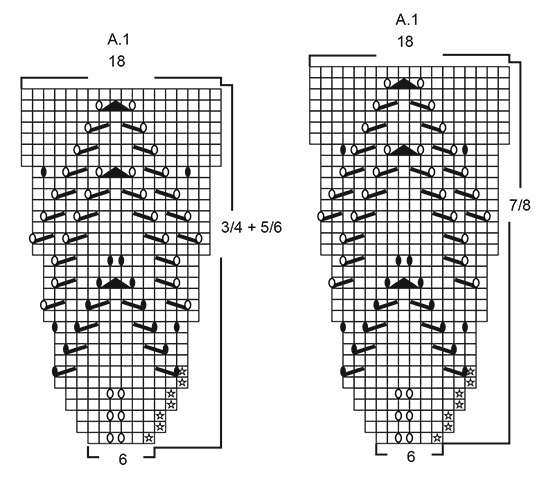 |
||||||||||||||||||||||
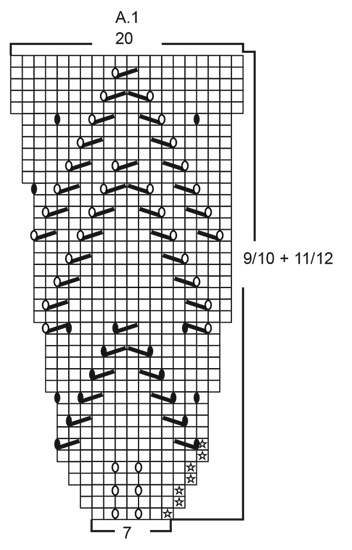 |
||||||||||||||||||||||
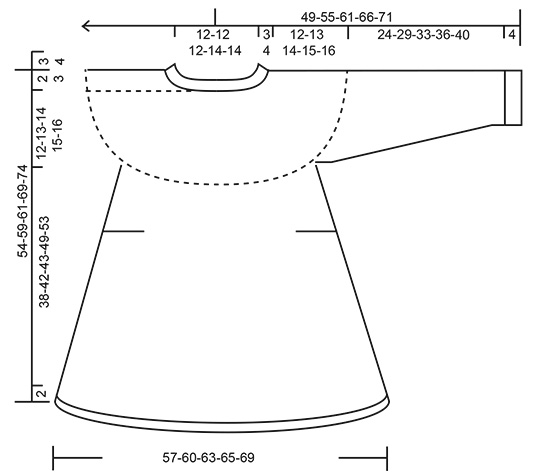 |
||||||||||||||||||||||
Have you finished this pattern?Tag your pictures with #dropspattern #woodlandfairydress or submit them to the #dropsfan gallery. Do you need help with this pattern?You'll find 23 tutorial videos, a Comments/Questions area and more by visiting the pattern on garnstudio.com. © 1982-2025 DROPS Design A/S. We reserve all rights. This document, including all its sub-sections, has copyrights. Read more about what you can do with our patterns at the bottom of each pattern on our site. |
||||||||||||||||||||||








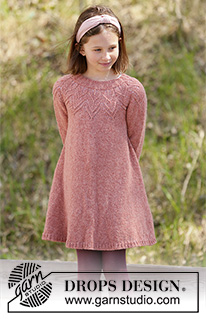
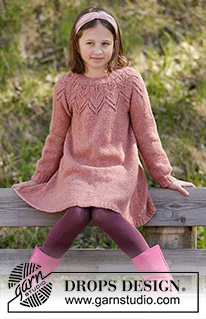
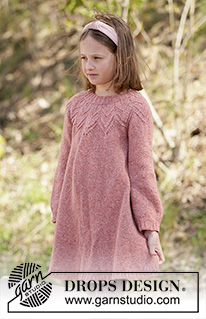





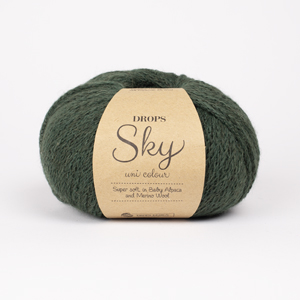
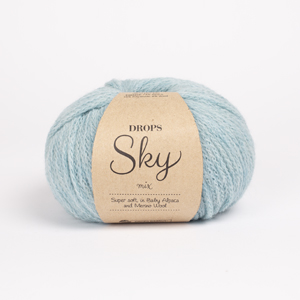


















































Post a comment to pattern DROPS Children 34-25
We would love to hear what you have to say about this pattern!
If you want to leave a question, please make sure you select the correct category in the form below, to speed up the answering process. Required fields are marked *.